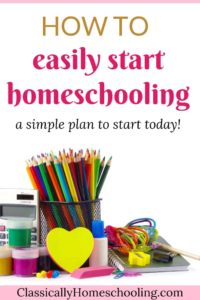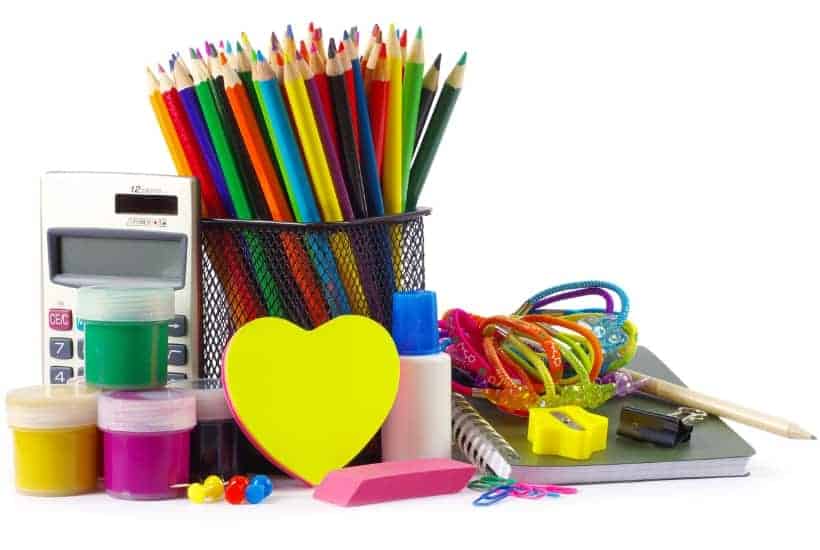An Easy Guide on How to Start Homeschooling Today
This post may contain affiliate links. For more information, please read my disclosure policy.
Are you looking for an easy guide on how to start homeschooling?
You have so many questions that arise, such as which math curriculum to purchase for the school year, what language arts program to use, and what books to assign for your child’s grade level.
You wonder what notebooking is and how to use rabbit trails. What is the best way to homeschool your kids at the kitchen table? How do you start homeschooling?
Today, I’m going to give you a quick guide for new homeschoolers on how to start your homeschool journey without losing your mind!
We’ll move slowly, covering one subject area at a time so that you can create an individualized home instruction plan that’s tailored to your family’s needs. Please keep in mind that the first year of homeschooling is challenging. You’re not only changing your educational method, but you’re also developing your own homeschooling style.
Give yourself grace. And remember that the most important thing is your relationship with your children. Hold onto that, and everything else will eventually fall into place. You can worry about creating your homeschooling schedule later.
How to Start Homeschooling: Reading
It’s a good idea to start your homeschooling with reading even if you start to homeschool mid-year. My recommendation for how to start homeschooling is simply to have your older children read every day. Even high school students benefit from just reading good books for a time, especially if they’ve only been reading snippets of books.
You can pull out a list of great children’s literature for the kids to read through or simply have them pull out a book of their choice.
On the other hand, younger children need to learn to read. So spend your time teaching your youngest kids how to read.
Because reading makes education so much easier.
A child who reads can curl up with a science book.
A child who reads can read directions.
And a child who reads can read word problems.
For that matter, a child who reads can read billboards to prompt all sorts of uncomfortable discussions!
When you’re learning how to start homeschooling, remember that the first step is to get your children reading and reading well.
Use Phonics Pathways or Ordinary Parents’ Guide to Teaching Reading, or Teach Your Child to Read in 100 Easy Lessons.
There are many other excellent programs as well. Choose one and work slowly and patiently through it. You’ll eventually teach your kids to read.
Otherwise, if your kids are reading, encourage them to spend plenty of time enjoying good books.
My 1st graders usually prefer to read picture books for quite a while before moving to chapter books in 2nd or 3rd grade.
Remember that picture books are designed to be read aloud and use more difficult words than early chapter books.
So don’t worry if it takes a while before your youngest son moves to chapter books.
Related Posts:
- Phonics Pathways and The Ordinary Parent’s Guide to Teaching Reading
- 21 Wonderful and Amazing History Books for Kids
- Twenty-One Awesome Dinosaur Books
- 11 Fantastic Books for Little Girls
- Two Awesome Series for Preteen Boys
How to Start Homeschooling Math
The next step is to figure out the math curriculum. There are many different types of math programs and teaching materials you can choose between that range from actual textbooks to online programs.
Don’t worry about your child’s age or grade level. Instead, use the placement tests to put your child at the correct level. This way, the material won’t be too easy or too hard.
A great way to start homeschooling math is to find a math curriculum that aligns with your family. By that, I mean the kids don’t burst into tears over learning math.
Believe me, nothing is worse than pulling out the day’s math assignment and seeing your child begin to sob.
You need to understand what’s being taught and why in your math curriculum. The children need to make forward progress. It helps if the math fits your child’s learning style. But I prefer the program to fit my teaching style for younger kids since I can adjust the lesson plans as needed. Older kids prefer more independence, so it’s more critical that the program is a good fit for them.
And don’t worry about moving slowly. Worry about diligence and mastery.
Recommended Math Curriculum to Start

As a place to start, know I use Saxon Math and love it. Mammoth Math is also excellent, as is Singapore Math and Right Start.
Many of my friends enjoy Teaching Textbooks.
Once you find a good math program, work through it daily. Make it part of your daily routine.
Eat breakfast, do chores, and pull out the math lesson.
Diligence will give you much better progress than trying to learn math sporadically.
And remember that your youngest kids can learn math through daily life.
- Teach your kids to count, add, and subtract.
- Encourage them to count money
- Cook together
Concentrate on making math part of your daily routine together.
Related posts:
- Saxon Math
- Want an Easy to Use, Excellent, and Affordable Math Curriculum?
- Free Printable Math Worksheets for Preschool-1st Grade
- 3 Reasons Kids Need Extra Math Practice & Where to Get It
- Stop the Struggle: Amazing Math Videos for Middle School Math
- Mammoth Math: An Easy Math Curriculum to Use
- Looking for an Engaging Grade K Math Curriculum?
- Mr. D ACT Math Bootcamp Review
- Top 10 Elementary Math Tips
How to start homeschooling Language Arts
Now that math is going smoothly, it is time to look into adding more academic skills… a language arts program. Remember, a slow and steady approach is best. It’s the next important step in your big decision to start homeschooling.
The first year or two of homeschooling is always the hardest because you’re learning how to start homeschooling. You’re trying to build an education from scratch and figure out what works best for your family members.
First things first. Begin by having your children in the elementary grades narrate and tell you about what they’ve read. Encourage them to give details without just going on and on and on.
At the same time, pick sentences or paragraphs for your kids to copy. This copy work will internalize grammar, spelling, and punctuation.
Take your time and look for a home school program that fits your needs and homeschool style.
There are many excellent all-in-one language arts programs, as well as the option of building your language arts piece by piece.
My language arts program for my children consists of Tapestry of Grace for literature and writing, Rod and Staff for grammar, and Spelling Workout for spelling.
If this is all you do for school at this time, you’ll keep your kids moving forward with reading, writing, and math. The critical skills needed for your children’s education.
Related Posts:
- A Complete Language Arts Curriculum Is the Solution
- Engaging Faith-based Reading and Language Arts Curriculum
- How to Use Spelling Workout
- Apples and Pears Spelling Review
- IEW’s Student Writing Intensive Level C Review
- 25 Fascinating & Silly Writing Prompts for Your Homeschool
- Top 10 High School Writing Tips
- Top 10 Middle School Writing Tips

How to Start Homeschooling Extra Subjects
My recommendation for how to start homeschooling the extra subject areas is to slowly add them to your daily schedules.
There’s much to say for strewing books around the house. Strewing simply means leaving good books on different subjects everywhere. Leave giant art books on the coffee table, bird books near the windows, and children’s literature in the bathroom.
Kids will discover the books when they’re bored, browse through them, and learn a bit as they go. By the end of the year, you’ll be amazed at all the little tidbits they’ve discovered about the world.
Start with nature study for an easy and fun introduction to science.
Use amazing history books and read them aloud with your kids.
Both of these offer countless opportunities to follow rabbit trails, as homeschoolers like to say. A rabbit trail is when you follow a line of exploration until you reach the end of the questions. It hops here, hops there, and by the end, your children have learned detailed information about a wide range of topics.
Once you have your feet underneath you, you can look into adding a formal history, social studies, or science curriculum to your homeschool schedule.
Related Posts
- How to Start Exploring Nature with Children
- 21 Wonderful and Amazing History Books for Kids
- Studying the History of Science with Beautiful Feet Books
- Study the Natural World with Beautiful Children’s Books
- 7 Amazing, Gross, and Fun Science Kits for Kids
How to Start Homeschooling with Rabbit Trails
Rabbit trails are one of the best parts of a homeschooling journey and an easy way to personalize your child’s education.
Simply put, you just follow your child’s interests.
For instance, when I initially outlined this post, my family was studying the Victorian Age.
My oldest daughter developed an interest in the etiquette of the time period, having read about the many dresses a lady needed to wear each day.
She then researched Victorian manners.
My son had no interest in Victorian manners, but he was fascinated by steam engines. Guess the rabbit trail he followed. Steam engines!
Rabbit trails don’t just arise from your history studies.
Kids can find topics they’d like to learn more about in science, children’s literature, or the last movie they watched.
Encourage your kids to spend time researching these topics and develop a love of learning in your kids. It’s an opportunity a traditional school can’t provide, but you, as a homeschooling parent, can.
Notebooking
Another great place to start homeschooling is to look into homeschool notebooking.
Notebooking is a homeschool method of recording your children’s lessons or rabbit trails. Your children write a sentence, paragraph, or essay about what they studied. The additional information is stored in a notebook so that you have a record of everything your child has studied over the school year.
Obviously, 1st and 2nd graders will write only a sentence while older children write paragraphs and essays.
The notebook pages become a documentary about your child’s studies each year. You can see the rabbit trails, the lessons learned, and the experiments completed. Writing also solidifies your child’s understanding of the material as well as gives you a portfolio to show grandparents.
And I need not mention that daily writing will improve your child’s writing like nothing else will.
The biggest secret on how to start homeschooling is to remember to take it slowly. Rome wasn’t built in a day. So concentrate on reading and math before trying to add other subjects to your day.
Have patience when you start homeschooling. In time, you’ll find your homeschool taking off.
And for more information on how to start homeschooling, read How to Easily Start Classical Education at Home.
My Workbook: Building Your Perfect Homeschool in just 13 Weeks is designed to hold your hands as you start homeschooling your kids.
Within 13 weeks, you’ll fulfill your dreams of giving your kids an enriching education at home!
Grab the workbook today!









We love rabbit trails and reading! Wonderful post!!!
Rabbit trails are awesome! Thanks, Erin. 🙂
What an awesome article!!
Thank you for sharing .. It’s always nice to be reminded of the truth that less really is more. We try to cram all the knowledge we can into one day one month or one year and we miss the rabbit trails which are probably the most important of all!!
This is such a great post, thank you so much.